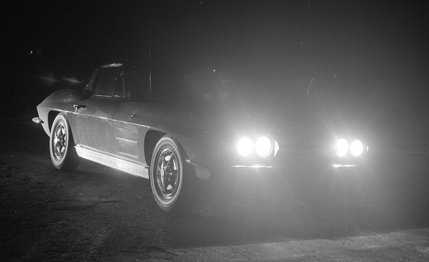TESTED
Waiting lists of great length and duration for the Corvette Sting Ray at all Chevrolet dealers’ are the best proof of the public’s acceptance of the new model. We hailed the car’s technical advances with great enthusiasm (Oct. C/D) after our brief test drives last fall.
Now it’s time for an exhaustive report on America’s leading grand touring car (which many drivers think of only as a sports car). We chose the 300-bhp version of the coupé, because it seems to enjoy some market preference over models equipped with the 250-, 340-, or fuel-injection 360-bhp engines.
|
|
However, the key to the personality of the Corvette Sting Ray lies neither in the power available nor in the revised styling, but in the chassis. Up to now the Corvette has been struggling to rise above a large number of stock components, notably in the suspension, where their presence created all kinds of problems that required extensive modifications for any competition use beyond normal road rallies. The new all-independent suspension has completely transformed the Corvette in terms of traction and cornering power, but it still has some faults. The standard setup on the test car seemed a bit more suitable for race tracks than for fast backroad motoring. A rigid front anti-roll bar in combination with a relatively stiff transverse leaf spring in the rear reduces the resilience and independence of the suspension of each wheel with the result that even on mildly rough surfaces the car does not feel perfectly stable. On bumpy turns it’s at its worst, veering freely from one course to another, making high-frequency corrections s.o.p., but on a smooth surface it comes incredibly close to perfection. Cornering stability under conditions permitting minimal wheel deflections is remarkable, and an initial feeling of pleasant surprise rises to sheer astonishment when one discovers that the car can be taken off the predetermined line with ease and still complete the turn in perfect balance.
There is some understeer but the car has such a tremendous power surplus, even with the next-to-bottom engine option, that the tail can be slung out almost any old time, and after a while throttle steering seems the natural way of aiding the car around a curve. This is so easy to do that a newcomer to the car can master it in half an hour of fast driving.
|
|
Given surface roughness, the rear end becomes skittish. We experienced this with a full tank as well as one almost empty, indicating that normal loads don’t appreciably affect its behavior in this respect.
One of our test cars had the new Saginaw power steering, three turns lock to lock with enough road feel to satisfy the most critical tester and observer, while eliminating all difficulties of parking and maneuvering in tight spaces. We also tested a car with manual steering, and found it so light in comparison with previous Corvettes that there can be no conceivable need for power assistance. While the power system is every bit as good as those used by Rover and Mercedes-Benz in terms of feedback and road feel, it seems strange that Chevrolet should get around to introducing it when there is no longer any need for it. The three-spoke wheel is steeply raked (15° 23′) as on previous Corvettes, and its relatively thin rim offers a good grip. The entire semi-circle between nine and three o’clock is free of spoke attachments, providing a clean hold for any but the most eccentric drivers. The steering column has a three-inch adjustment for length but our test drivers all kept the wheel in its foremost (bottom) position while making the most of seat-adjustment possibilities. There are four inches of fore-and-aft travel but backrest angle is variable only by setting screws at its floor abutments. In addition, there are three seat-height positions with a total span of 1.24 inches.
View Photos
View Photos


Leave a Reply